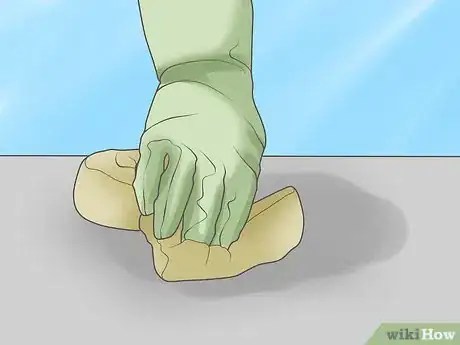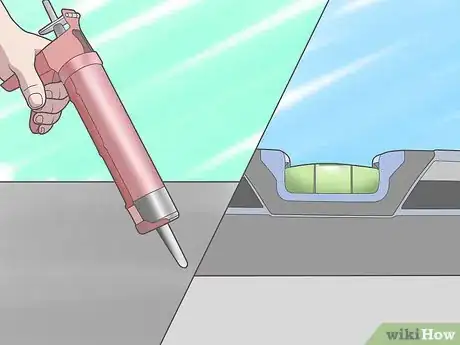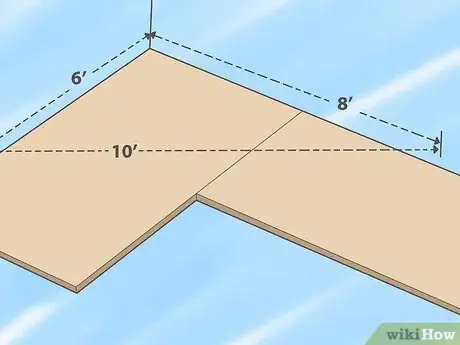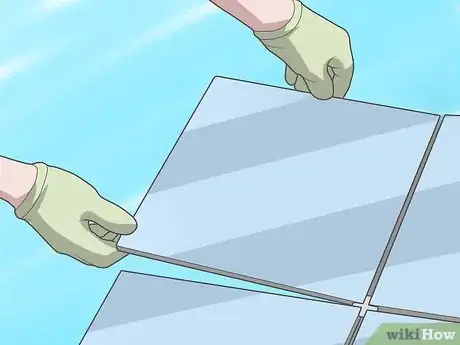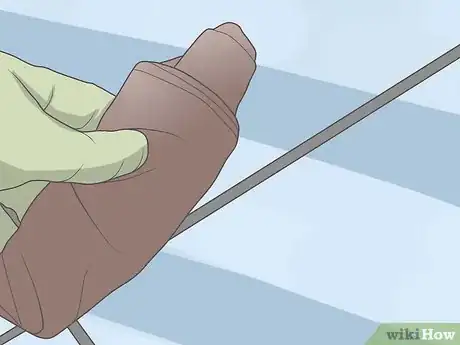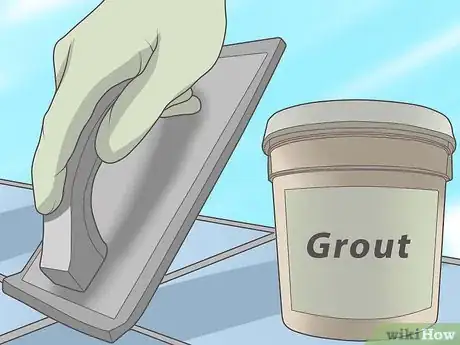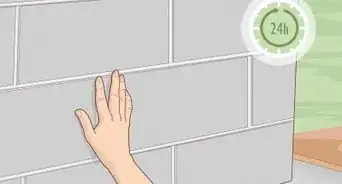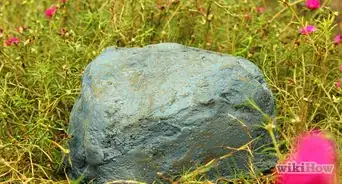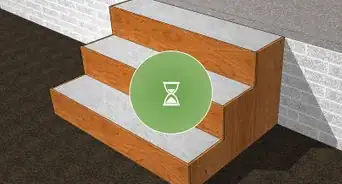X
wikiHow is a “wiki,” similar to Wikipedia, which means that many of our articles are co-written by multiple authors. To create this article, 9 people, some anonymous, worked to edit and improve it over time.
wikiHow marks an article as reader-approved once it receives enough positive feedback. This article received 15 testimonials and 94% of readers who voted found it helpful, earning it our reader-approved status.
This article has been viewed 270,520 times.
Learn more...
Installing ceramic tiles over concrete can help to create a more inviting indoor or outdoor living space.
Steps
-
1Prepare the concrete. Using an acid based cleaner or deep cleaner of your choice, clean the concrete and allow it to dry thoroughly. Examine the floor and see if there are any cracks or pits that need to be fixed and use the proper concrete repair kit to repair them.[1]
- A muriatic or other acid-based cleaner is usually the best way to completely clean the concrete prior to installing tile.
-
2Seal and level the concrete. Once your repairs have dried, take the time to seal the concrete. Once the sealer has dried, apply the concrete patch or leveler and make sure that you have a flat surface with no defects. The floor must be level or your tiles and grout will form cracks.[2]
- Cleaning the concrete should be done before adding a floor leveling compound. A sodium silicate or lithium silicate based sealer will help to waterproof and strengthen the concrete. Because silicates work below the surface, they won’t interfere with adhesion.
Advertisement -
3Plan the tile layout. Before installing the tile it is a good idea to lay out your design. Pre-plan which and how many pieces of tile have to be cut and where the cut tile will be placed. Chalk lines will become very helpful so make sure you mark the floor.[3]
-
4Mix the mortar. After you have decided where you want to begin, follow the instructions provided by the manufacturer and begin to mix the mortar. Don’t mix too much in advance, as it will begin to set up on you before you can use it. Using your grooved trowel, begin spreading the mortar over a small area. Never spread out more than what you can cover with three or four tiles at a time.[4]
- Different kinds of tile require different types of mortar. Ask the sales representative who sells you the tile to help you choose the right one.
- A grooved trowel will be necessary to spread the mortar. They are available with different sized grooves, so be sure to read the package directions on the mortar to ensure that you buy the right size.
-
5Install the tiles. Lay the tiles into the mortar and using the spacers, make sure you are running even with the chalk line. As you move on to the subsequent rows, use the spacers to keep your pattern square. Once a tile is set, try to avoid touching it again.[5]
-
6Clean the area. Wash the tiles off with a damp rag as you go to prevent clumps of mortar from drying on the surface. As you get to the end of the room, make sure your cut pieces fit properly, and then leave the mortar to dry for the manufacturer’s specified length of time.
-
7Apply grout. Mix the grout as specified on the package and begin liberally spreading it over the tile using the grout float. Use the float to make sure that there are no low spots, and then use a damp rag to wipe any excess grout from the face of the tile. Don’t worry at this point if the tile appears a little cloudy. Once the grout has had time to set up, repeat the process, again using the float to squeegee and extra grout off of the face of the tile.[6]
- Aside from being available in many different colors, grout comes in two varieties: sanded and un-sanded. The sanded variety is used when the gaps between your tiles is bigger than 1/8″. The sand gives the grout additional strength. Anything 1/8″ or smaller will be just fine using un-sanded grout. You will most likely find that you want to use the un-sanded grout in the smaller gaps because it finishes much smoother. Working sanded grout into a small gap can be frustrating.
- One word of warning: if you are using marble tile on your floor, never use sanded grout! Make sure you install it with 1/8″ or smaller gap because you must use un-sanded grout with marble. The sanded grout will scratch the surface of the marble tile and it is not repairable.
-
8Clean up. Once the grout is completely dry, take a wet rag and wash the surface of the entire floor. As the floor dries, you will probably notice a haze forming over the tile. Allow it to dry completely again, and then go back over it with a slightly damp rag – this should polish the haze right off.
- A grout float can be used to work the grout into the gaps between the tiles.
-
9Seal the grout. Once you have polished the remaining grout and mortar residue off of the floor and you are confident that the grout has fully cured, use the grout sealer to prevent stains and mildew from taking hold in the future.[7]
Advertisement
Community Q&A
-
QuestionHow do I maintain tile height when installing with a trowel?
 Community AnswerIf I understand the question correctly, you are concerned with low or high spots from the application of your thin-set. By using a notched trowel to apply thin-set, you will be applying the same depth of thin-set across the floor. The notches spread the mixture to the same level with each spread so high/low spots cannot occur. Pay attention to the depth/size of the notches when purchasing your trowel.
Community AnswerIf I understand the question correctly, you are concerned with low or high spots from the application of your thin-set. By using a notched trowel to apply thin-set, you will be applying the same depth of thin-set across the floor. The notches spread the mixture to the same level with each spread so high/low spots cannot occur. Pay attention to the depth/size of the notches when purchasing your trowel. -
QuestionDo I have to use spacers between the tiles, or can they be laid without spacing?
 Community AnswerYou can lay tiles on the floor without using spacers on floors, but it is much easier to maintain consistency with them. You will need spacers if you are tiling walls, however.
Community AnswerYou can lay tiles on the floor without using spacers on floors, but it is much easier to maintain consistency with them. You will need spacers if you are tiling walls, however. -
QuestionCan I lay tile over tile?
 Community AnswerYou can, but I wouldn't recommend it, as the lower tile will deteriorate over time.
Community AnswerYou can, but I wouldn't recommend it, as the lower tile will deteriorate over time.
Advertisement
Things You'll Need
- Cleaner
- Concrete patch/floor leveler
- Concrete sealer
- Tile
- Mortar
- Trowel
- Grout
- Grout float
References
- ↑ https://www.todayshomeowner.com/video/installing-tile-outside-on-a-concrete-porch-or-patio/
- ↑ https://www.granadatile.com/blog/how-to-seal-cement-tile-grout/
- ↑ https://www.youtube.com/watch?v=3vGUtY4izPk
- ↑ https://www.todayshomeowner.com/video/installing-tile-outside-on-a-concrete-porch-or-patio/
- ↑ https://www.greenbuildingadvisor.com/article/how-to-install-tile-over-concrete
- ↑ https://www.granadatile.com/blog/how-to-seal-cement-tile-grout/
- ↑ https://www.granadatile.com/blog/how-to-seal-cement-tile-grout/
About This Article
Advertisement
